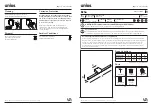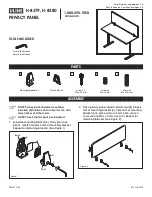
Making Measurements
Light Response Curves
4-26
Using the LI-6400
4
have a CO
2
mixer, this is simple to do: set it to control on sample CO
2
con-
centration.
Temperature
Ideally, the response curve should be measured at a constant temperature. The
LED light source does not put a large energy load on the leaf, so the differ-
ence between full sun equivalent and dark can easily be compensated by the
temperature controllers; operate them for a constant leaf temperature.
Humidity Control
Operate the flow control for constant water mole fraction. If you go from light
to dark, expect conductances and transpiration rates to fall, so leave room for
the flow to fall as well (or rise, if you are going from dark to light).
Matching
Since the concentrations in the IRGAs arenÕt going to be changing much dur-
ing a light curve, thereÕs no real reason to match after every measurement.
Match once before starting. If you are doing a slow curve, however, matching
wonÕt hurt anything, since youÕll have time to burn.
With OPEN version 3.2 and above, you are asked for a matching threshold
(the absolute value of the
D
CO
2
value). Thus, you donÕt have to decide
whether to match before each observation or not; it will match on the ones
with
D
CO
2
smaller than your threshold, and skip the rest.
Real Time Graphics
Two useful, pre-defined configurations for Real Time Graphics displays are
"A-Q, g-Q, totalCV"
"A-Q, RH_Flow, totalCV"
The first plots photosynthesis and conductance as functions of light on xy
plots (shows logged data), and has a strip chart for
totalCV
. The second re-
places the conductance plot with a plot of humidity vs. flow rate. This lets you
monitor the flow/humidity status during the measurement, without having to
leave the graphics display. (Figure 4-7).
Summary of Contents for LI-6400
Page 1: ...Using the LI 6400 Portable Photosynthesis System ...
Page 15: ...Part I The Basics ...
Page 16: ......
Page 174: ...Making Measurements Answers to Questions 4 56 Using the LI 6400 4 ...
Page 175: ...Part II Useful Details ...
Page 176: ......
Page 200: ...Standard Tools Power ON Hooks 5 24 Using the LI 6400 5 ...
Page 214: ...Real Time Data Real Time Graphics 6 14 Using the LI 6400 6 ...
Page 234: ...Environmental Control Light Control 7 20 Using the LI 6400 7 ...
Page 244: ...Light Sensor Considerations Gallium Arsenide Phosphide GaAsP Sensor 8 10 Using the LI 6400 8 ...
Page 288: ...Data Logging Making Your Own AutoPrograms 9 44 Using the LI 6400 9 ...
Page 289: ...Part III Working With Files ...
Page 290: ......
Page 312: ...The LPL File System Troubleshooting 10 22 Using the LI 6400 10 ...
Page 340: ...Downloading Files Using a Data Capture Program 11 28 Using the LI 6400 11 ...
Page 375: ...Part IV Configuration Issues ...
Page 376: ......
Page 420: ...Defining User Variables Old Style vs New Style 15 18 Using the LI 6400 15 ...
Page 454: ...Using an Energy Balance Further Reading 17 12 Using the LI 6400 17 ...
Page 455: ...Part V Maintenance Troubleshooting ...
Page 456: ......
Page 572: ...Troubleshooting Useful Information 20 46 Using the LI 6400 20 ...
Page 593: ...Part VI Programming ...
Page 594: ......
Page 622: ...Programming with LPL Compiler Directives 22 28 Using the LI 6400 22 ...
Page 846: ...Index I 16 Using the LI 6400 ...
















































